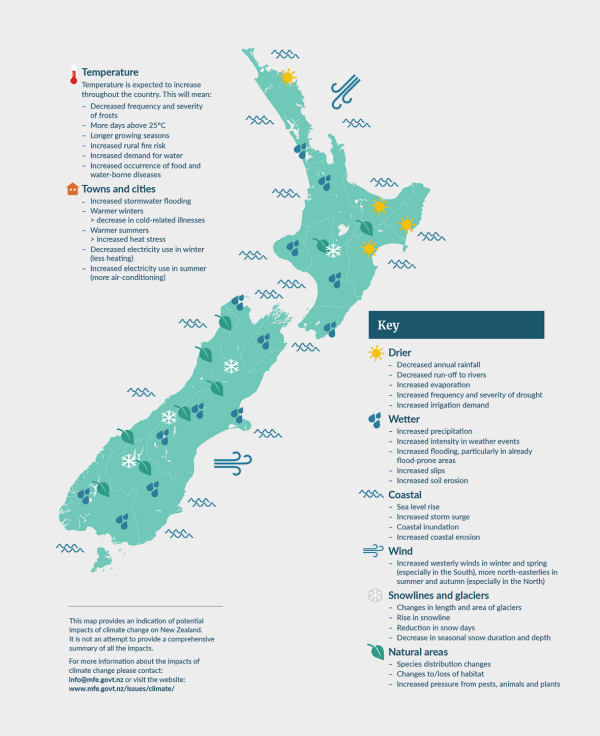Projected changes to New Zealand’s climate
New Zealand has already experienced around 1.1°C of warming since the beginning of the 20th Century. And further warming is unavoidable due to greenhouse gases emitted over past decades. The Paris Agreement aims to limit warming to no more than 2°C above pre-industrial levels and to pursue efforts to limit the temperature increase even further to 1.5°C.
An increase in 1 or 2° C may not seem a lot, but for context – average global temperatures are now only 5° C higher than at the peak of the last ice age. You may find this page useful for understanding more about the science of climate change.
Ministry for the Environment information
On the right is a map from the Ministry for the Environment (MfE) that gives an overview of expected climate change impacts for New Zealand over the next century.
The Ministry for the Environment (MfE) website provides further information and reports on New Zealand's changing climate, including; Climate Change Projections for New Zealand and Our atmosphere and climate 2020.
NIWA climate change projections resources
For an easy-to-understand national summary on expected climatic changes, check out NIWA's page about climate change projections, which includes a 6-minute video giving a national overview.
In 2024 NIWA worked with the Ministry for the Environment to produce updated climate projections for Aotearoa New Zealand. You can explore these here.
Drought specific information can be found through NIWA's Drought Monitor and through the Deep South Challenge Drought Risk Report.
Detailed climate change projections by region
The next page of this toolbox, Projected regional climate change hazards, provides a summary of projected climate change hazards for New Zealand, broken down by climate region/zone:
- Zone 1: Upper North Island (Te Ika ā Māui)
- Zone 2: Western lower North Island (Te Ika ā Māui)
- Zone 3: Eastern lower North Island (Te Ika ā Māui)
- Zone 4: Northern South Island (Te Wai Pounamu)
- Zone 5: Eastern South Island (Te Wai Pounamu)
- Zone 6: Western and southern South Island (Te Wai Pounamu)
- Zone 7: Chatham Islands (Wharekauri – Rēkohu) and Pitt Island (Rangiauria –Rangiaotea)
This information is based on current climate models and projections for New Zealand produced using NIWA’s Regional Climate Model.
For many councils and other organisations around New Zealand, NIWA has carried out bespoke modelling to provide specific advice about expected climate changes and impacts.
Local government-related resources
MfE has three comprehensive reports on climate change projections for New Zealand and their impacts, particularly with respect to Local Government activities:
- Preparing for climate change: A guide for local government in New Zealand, with a supplementary report on the updated climate change projections based on the IPCC 5th Assessment Report
- Preparing for future flooding: A guide for local government in New Zealand
- Preparing for coastal change: A guide for local government in New Zealand
Agriculture and horticulture-related resources
Increases in mean temperature and changes to seasonal rainfall will present land managers with challenges and new opportunities. Adapting to different future conditions is critical for farmers and growers to remain sustainable, resilient and productive. You may find the following websites useful:
- MPI Adverse Events
- MPI Sustainable Food and Fibre Futures projects (previously, the Sustainable Farming Fund)
- The Pastoral Greenhouse Gas Consortium
- Fertiliser code of practice
- Overseer nutrient budgets
- Sustainable land management and hill country erosion
- Visual soil assessment field guide
- Irrigation NZ and the efficient use of water
- Deep South primary sector preparedness
- Adverse Events - DairyNZ
- Knowledge Hub - Beef + Lamb New Zealand

